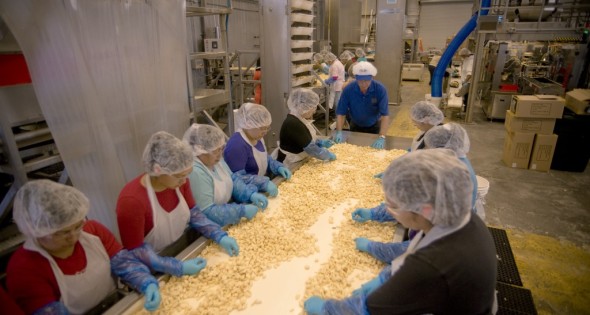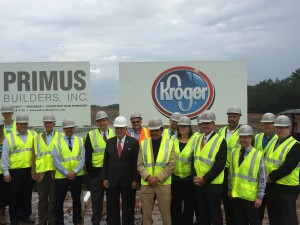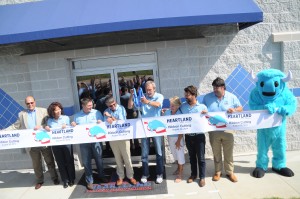
Food and Beverage Processors Look Forward to a Winning Year
26 Feb, 2015
Caption: Garlic production line at Christopher Ranch LLC in Gilroy, California. Photo: Christopher Ranch.
By Mark Kleszczewski
Communities and companies are ready to meet the demands for specialty foods.
Heading into 2015, the U.S. food and beverage industry — which accounts for roughly one-fifth of the nation’s economic activity — faces several challenges, but continues to be a dynamic sector with strong prospects for future growth, say industry leaders.
Agricultural and food processing companies will have to figure out how to navigate key drivers such as advances in processing technology, food safety and shifting consumer tastes, but the overall future looks good, notes Jay Garner, president, Garner Economics LLC.
“There is no such thing as a recession-proof industry, but the food and beverage sector comes pretty close to it,” he says. “I don’t think we’ll see as much consolidation as we did during the recession when second- and third-tier food companies were either bought up or driven out of business by stronger players. But we’re still going to see growth, primarily attributed to automation and new production lines associated with consumer-driven preferences.”
In particular, Garner and other industry analysts see continued, growing demand for ethnic foods (especially by Hispanic consumers), nutraceuticals and functional ingredients, organic and specialty foods, ready-to-eat meals and private-label brands.
Growing Appetites Drive Investments
Demand for value-added products is especially strong, with specialty foods accounting for record-breaking sales of $88.3 billion in 2013 and organic product sales jumping to $35.1 billion in 2013, up 11.5 percent from the previous year’s $31.5 billion — the fastest growth rate in five years.
Rising global demand, primarily in developing countries, propelled American agricultural and food exports to grow faster than imports on average in the past decade, widening the U.S. agricultural trade surplus to $37.1 billion in 2013, the U.S. Department of Agriculture reports.
Among the main contributors to that surplus is Pennsylvania, whose manufactured food products are among its fastest-growing exports, increasing to more than 70 percent in the last five years.
In the domestic market, Pennsylvania accounts for $32 billion in annual food shipments and ranks fourth in the nation in value-added products from meat and poultry to chocolate and baked goods. It’s also a major center of family-owned food businesses like Dietz & Watson, which has started construction on a new $50 million “food campus” located next to its existing production location in Philadelphia.

Georgia Gov. Nathan Deal (without yellow vest) with Kroger and community officials at the December 2014 groundbreaking for Kroger’s $175 million distribution center project in Forest Park. Photo: Clayton County (Ga.) Office of Economic Development & Film
“This is a tremendous opportunity for our family-owned company to grow in the city and state that has supported us for 75 years,” said Louis Eni, president and CEO, Dietz & Watson, in a recent statement. “This new food campus in Tacony will allow us to operate more efficiently, so that we can better prepare and distribute the hundreds of delicious Dietz & Watson products to our customers all across the U.S.”
The expansion — projected to add 158 new jobs — will feature a 200,000-square-foot distribution center, state-of-the-art conveyer system and a new fleet-maintenance facility. It will also add approximately 20 acres to the company’s existing 22 acres along the North Delaware waterfront, while supporting a boat launch, expanded public riverfront trails and open space, and 30 acres to be available for future commercial and industrial development.
Evolving Beyond Production
California may lead the country as its largest producer of agricultural products — accounting for almost 11 percent of the national total — but it’s not just large-scale output of commodities that drives the state’s ag and food industry. California also ranks No. 1 in the number of food processing facilities, many of them taking hold in communities now expanding their role in today’s food system.
“We’re well-known for wineries, garlic and fresh, raw products like spinach that can go from farm to store in 24 hours, but we also have a burgeoning food processing cluster that’s attracting companies in the next level of the supply chain,” says Tammy Brownlow, president and CEO, Gilroy (Calif.) Economic Development Corp.
Major food businesses in the area include Christopher Ranch, Olam International Ltd., Monterey Gourmet Foods Inc., Silva Sausage, Wheat Valley Bakery and Blossom Valley Foods. These businesses provide employment for more than 1,500 workers in Gilroy and support the growth of a cluster that provides packaging, equipment and other goods and services for their operations, Brownlow explains.
She notes that a new distribution facility being built by United Natural Foods Inc., a leading independent national distributor of natural, organic and specialty foods, will also have a major impact on the local economy. The company is now building phase one of its state-of-the-art distribution center on 53 acres in McCarthy Business Park. At full build out, the facility will total 800,000 square feet and eventually employ 450 new full-time associates, generating an additional $142 million of additional business revenue.
With quality concerns and food safety considerations on the rise, handling product safely and getting it to market quickly and efficiently is paramount.
Over in the Midwest, Topeka, Kan., is at the crossroads of Interstate 70, which runs east and west, and Interstate 35 and U.S. Highway 75, running north and south. The region is home to both human and pet food companies, as well as a large distribution center for U.S. Foods Inc.
Topeka’s location allows for companies to move products in and out easily. Companies that call Topeka home include Reser’s Fine Foods Inc., Mars Chocolate North America, Frito-Lay Inc. and Bimbo Bakeries. Among the area’s pet food companies are Hill’s Pet Nutrition Inc.
Also in the Midwest, food and beverage companies like General Mills Inc., Butterball/Gusto Packing Co., Performance Food Service-Fox River, Superior Beverage Co. and Eby-Brown have found a sweet spot in Montgomery, Ill.
“Although we have a limited growing season, there’s quite a few things here in our favor that food processors like, so in the last couple of years we’ve had a lot of activity,” says Charlene Coulombe-Fiore, executive director, Montgomery (Ill.) Economic Development Corp. “Having extensive, open highways and vacant land with good access to BNSF rail means that products can be shipped and delivered in a timely manner in this region. You’re truck is not going to sit on a highway for hours costing you money like it will closer to Chicago.
“Being nestled between two of the largest cities in the Chicagoland region also lets us provide quite a wide array of labor from pickers, packers and warehouse people to management and transportation professionals,” Coulombe-Fiore continues. “We have a labor pool of over 800,000 people within a five-mile range, and processors are definitely interested in taking advantage.
“When you have a company like Performance Foods expanding here five times in the last five years, that’s exciting — especially when it’s been during tough times,” she adds.
Whether it’s high-value perishables or consumer packaged goods, world-class transportation infrastructure is what makes Clayton County, Ga., a primary logistics corridor for the Atlanta State Farmer’s Market and companies like Dole Foods Co., Del Monte Foods Co., Chiquita Brands International Inc., Fresh Express and Sara Lee/Ralcorp.
In Topeka, the Washburn Institute of Technology, an affiliate of Washburn University, has put together customized programs to assist food manufacturers with recruiting employees and training employees with the necessary skills so they are prepared to hit the ground running at these facilities.
“It’s the underlying driver for the region, thanks to the direct connection between our interstate highways, rail to the ports of Savannah and Brunswick, and one of the world’s busiest airports,” says Grant M. Wainscott, director, Clayton County Office of Economic Development & Film. “Rather than just randomly try to pull in a big food manufacturing plant, we made a concerted effort to build up our food logistics side. That approach hit at a great time in the industry and helped attract the upcoming Kroger’s $175 million distribution center relocation to Forest Park.”
Another example Wainscott points to is the Castellini Group’s announced investment of $52 million to develop a large-scale, fresh-cut fruits and vegetables processing and produce distribution center in Conley, leading to 300 jobs. The new 180,000-square-foot facility — slated to open this September — will enable the company to reach 80 percent of the U.S. market within a single day’s truck drive.
In New Jersey, targeted public initiatives like the Grow New Jersey Assistance Program (Grow NJ) combined with the state’s convenient location allow a wide variety of food operations to service the country’s largest population center, says Michael Chrobak, chief economic development officer, Choose New Jersey.
“Strategically located in the heart of the Northeast corridor, the state provides ready access to more than 130 million consumers all within a day’s drive. A distribution center in central New Jersey can serve more than 20 million consumers with $1 trillion in income within a two-hour drive, making the area ideal for same-day deliveries,” Chrobak says. “Location was a major factor in why the largest retailers’ supermarket co-op in the U.S., Wakefern Foods, opened an all-new $50 million, 524,000-square-foot dry goods warehouse and distribution facility in Elizabeth.”
The state is also a front runner when it comes to food industry heavyweights siting their headquarters. Notable names include Campbell Soup Co., Unilever, Pinnacle Foods Group and Goya Foods Inc. It’s also home to the world’s leading flavor, fragrance and ingredient manufacturers, ranging from small and mid-sized companies to multinationals such as Givaudan Fragrances Corp. and International Flavors & Fragrances Inc. At last count, this subsector totaled 128 firms with gross sales of $5.2 billion.
Pet Food Goes Upscale
By Mark Kleszczewski
As American consumers become more educated about ingredients, nutrition and food safety — in turn driving record-breaking demand for natural, organic and specialty foods — more and more people are taking a similar approach with their pets.
According to industry researcher GfK, two-thirds of all U.S. dog food and 41 percent of cat food sales in 2013 were in the “natural” category, growing at 11.7 percent year-over-year while generating $4.6 billion in sales annually.
The increasing emphasis on more whole meats and fewer additives has created a big opportunity for communities who can meet the demand for natural, grain-free and “limited ingredient” foods.Ribbon-cutting at Heartland Pet Products’ Joplin, Missouri location, August 2014. Photo: Joplin Area Chamber of Commerce
Already a thriving base for the likes of Annie’s Homegrown, Cott Beverages Inc. and nearly 50 other food processing companies, Joplin, Mo. has become a prominent center for specialty pet food production in the United States.
Thanks to plentiful, high-quality sources of proteins and grains, along with convenient interstate access to major metro markets, Joplin is an excellent location for pet food operations needing to get raw materials in and finished goods out quickly, explains Rob O’Brien, president, Joplin Regional Partnership.
Furthermore, he says, companies can draw from a specialized, regional workforce experienced in nutrition, food safety, packaging and storage. Area companies taking advantage of these capabilities are Hampshire Pet Products in Joplin, Day Six Pet Nutrition in Baxter Springs, Kan., and Triple T Foods in Frontenac, Kan.
They’ve been joined recently by the maker of Blue Buffalo pet food, Heartland Pet Foods Manufacturing, which opened a highly-automated, 415,000-square-foot factory and full-service distribution center in Joplin’s Crossroads Industrial Park, bringing with it 150 full-time manufacturing jobs.
Blue Buffalo’s high-profile presence — to the tune of $90 million — is likely to lead to opportunities with other companies in this booming specialty sector. “We believe there will be some Heartland suppliers that currently don’t have a presence here, but will eventually come here in order to serve the Heartland plant,” O’Brien says.
For complete details, visit www.joplinregionalpartnership.com.
Securing a Successful Future
The industry may be on the upswing, but a community’s success in the sector is not going to happen just because it offers good assets, Garner suggests. “For example, having excellent water, certified sites, or skillset expertise is certainly helpful, if not a must — but those still need to be marketed aggressively,” he says.
In Topeka, the Washburn Institute of Technology, an affiliate of Washburn University, has put together customized programs to assist food manufacturers with recruiting employees and training employees with the necessary skills so they are prepared to hit the ground running at these facilities, says Scott Smathers, vice president of economic development, GoTopeka.
“Gilroy may be attractive to food manufacturers and distributors because of our growers and connectivity to the Bay Area, Central Valley, and Salinas Valley,” Brownlow says. “But more and more it’s made sense for us to attract additional companies in the wider industry, from packaging, production equipment to contract manufacturing. Today if you shop at Costco, Sam’s Club or any of the major grocery chains, you’re probably buying food that was processed here in Gilroy.”
“Logistics and location are a big part of the investments happening here, but finding a niche that plays to our strengths within the industry was very important,” says Georgia’s Wainscott. “Like getting Kia to come to Georgia, knowing ourselves and how we can offer better or cheaper options than other places is one of the reasons we’ve been able to attract the Kroger project. We seem to have found our way in what’s become a huge market for us.”
Smathers says Topeka has been fortunate in the fact that food processing companies have been expanding some. “We have some interest from other companies in our area and we hope that continues to grow,” he says. “We would love to build on the cluster we feel we have established because it allows us to provide more specialized training and it is a good fit for our area.”
For complete details on the organizations featured in this article, visit:
Clayton County (Ga.) Office of Economic Development & Film












